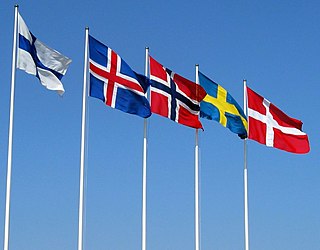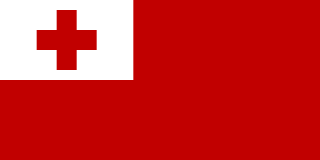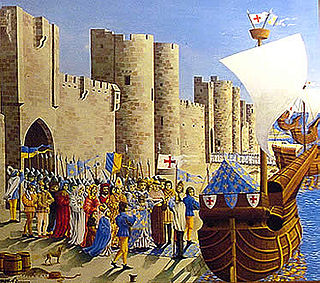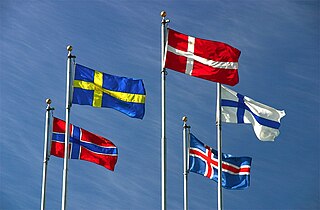
A national flag is a flag that represents and symbolizes a given nation. It is flown by the government of that nation, but can also be flown by its citizens. A national flag is typically designed with specific meanings for its colours and symbols, which may also be used separately from the flag as a symbol of the nation. The design of a national flag is sometimes altered after the occurrence of important historical events. The burning or destruction of a national flag is a greatly symbolic act.

The Union Jack or Union Flag is the de facto national flag of the United Kingdom. The Union Flag was also used as the official flag of several British colonies and dominions before they adopted their own national flags. The flag continues to have official status in Canada, by parliamentary resolution, where it is known as the Royal Union Flag.

The national flag of France is a tricolour featuring three vertical bands coloured blue, white, and red. It is known to English speakers as the Tricolour, although the flag of Ireland and others are also known as such. The design was adopted after the French Revolution, where the revolutionaries were influenced by the horizontally striped red-white-blue flag of the Netherlands. While not the first tricolour, it became one of the most influential flags in history. The tricolour scheme was later adopted by many other nations in Europe and elsewhere, and, according to the Encyclopædia Britannica has historically stood "in symbolic opposition to the autocratic and clericalist royal standards of the past".

The Flag of Finland, also called siniristilippu, dates from the beginning of the 20th century. On a white background, it features a blue Nordic cross, which represents Christianity.

The flags of the Confederate States of America have a history of three successive designs during the American Civil War. The flags were known as the "Stars and Bars", used from 1861 to 1863; the "Stainless Banner", used from 1863 to 1865; and the "Blood-Stained Banner", used in 1865 shortly before the Confederacy's dissolution. A rejected national flag design was also used as a battle flag by the Confederate Army and featured in the "Stainless Banner" and "Blood-Stained Banner" designs. Although this design was never a national flag, it is the most commonly recognized symbol of the Confederacy.

The national flag of Greece, popularly referred to as the "turquoise and white one" or the "azure and white", is officially recognised by Greece as one of its national symbols and has 5 equal horizontal stripes of blue alternating with white. There is a blue canton in the upper hoist-side corner bearing a white cross; the cross symbolises Eastern Orthodox Christianity. The blazon of the flag is Azure, four bars Argent; on a canton of the field a Greek cross throughout of the second. The official flag ratio is 2:3. The shade of blue used in the flag has varied throughout its history, from light blue to dark blue, the latter being increasingly used since the late 1960s. It was officially adopted by the First National Assembly at Epidaurus on 13 January 1822.

The flag of Bulgaria is a tricolour consisting of three equal-sized horizontal bands of white, green, and red. The flag was first adopted after the 1877–1878 Russo-Turkish War, when Bulgaria gained de facto independence. The national flag at times had as a supplement the state emblem, especially during the communist era. The current flag was re-established with the 1991 Constitution of Bulgaria and was confirmed in a 1998 law.

The national flag of Switzerland displays a white cross in the center of a square red field. The white cross is known as the Swiss cross or the federal cross. Its arms are equilateral, and their ratio of length to width is 7:6. The size of the cross in relation to the field was set in 2017 as 5:8. Alongside the flag of Vatican City, the Swiss flag is one of only two square national flags in the world.

The flag of Jamaica was adopted on 6 August 1962, the country having gained independence from the British Empire. The flag consists of a gold saltire, which divides the flag into four sections: two of them green and two black. It is currently the only national flag that does not contain a shade of the colours red, white, or blue. Jamaica's national flag is also sometimes referred to as “The Cross” or as the “Black, Green, and Gold” due to its form and colours.

In vexillography, the canton is a rectangular emblem placed at the top left of a flag, usually occupying up to a quarter of a flag's area. The canton of a flag may be a flag in its own right. For instance, British ensigns have the Union Jack as their canton, as do their derivatives such as the national flags of Australia and New Zealand.

The White Ensign, at one time called the St George's Ensign because of the simultaneous existence of a crossless version of the flag, is an ensign worn on British Royal Navy ships and shore establishments. It consists of a red St George's Cross on a white field, identical to the flag of England except with the Union Flag in the upper canton.

The Christian Flag is an ecumenical flag designed in the late 19th century to represent much of Christianity and Christendom. Since its adoption by the United States Federal Council of Churches in 1942, it has had varied usage by congregations of many Christian traditions, including Anglican, Baptist, Congregationalist, Lutheran, Mennonite, Methodist, Moravian, Presbyterian, and Reformed, among others.

A Nordic cross flag is a flag bearing the design of the Nordic or Scandinavian cross, a cross symbol in a rectangular field, with the centre of the cross shifted towards the hoist.
The island nation of Malta has a variety of national flags and symbols, some current and some no longer in use.

New England has no official flag. However, there have been many historical or modern banners used to represent the region in its history. While there are some variations, common designs include a plain colored field with a pine tree in the canton. The eastern white pine is the most common and prominent symbol of New England and is featured on many of the region's flags.

The following outline is provided as an overview of and topical guide to Tonga:

Sālote Lupepauʻu was Queen of Tonga from 1845 to 1889 as the wife of George Tupou I. She was the namesake of the Queen Salote College.

The flag of the East India Company was used to represent the East India Company, which was chartered in England in 1600. The flag was altered as the nation changed from England to Great Britain to the United Kingdom. It was initially a red and white striped ensign with the flag of England in the canton. The flag displayed in the canton was later replaced by the flag of Great Britain and then the flag of the United Kingdom, as the nation developed.

The history of Christian flags encompasses the establishment of Christian states, the Crusader era, and the 20th century ecumenical movement.

Flag families are sets of national flags with similarities in their design, often based on a shared history, culture, or influence. Families do not include flags with coincidental similarities. Flags may be in multiple flag families. Only twelve current national flags existed before the 19th century, when large-scale flag use began. Seven of these flags are the inspiration for more than 130 current national flags and ensigns.






























